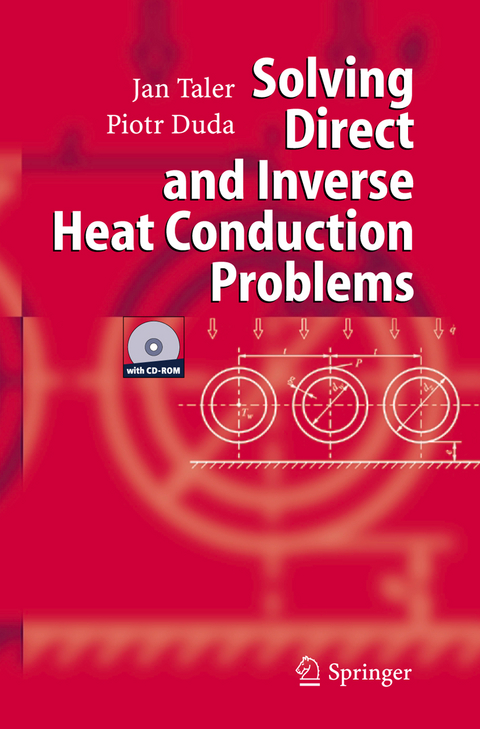
Solving Direct and Inverse Heat Conduction Problems
Springer Berlin (Verlag)
978-3-540-33470-5 (ISBN)
Professor Jan Taler is a director of the Department of Process and Power Engineering at the Faculty of Mechanical Engineering, Krakow University of Technology. He has lectures on heat transfer processes and thermal power plants at the Faculty of Mechanical Engineering and the Faculty of Computer and Electrical Engineering. His research interests mainly lie in heat transfer, inverse heat conduction problems and monitoring of thermal stresses, which arise during the operations of energy installations and machinery. The results of his research on heat transfer, thermal stresses, optimum heating and cooling of solids and measuring of heat flux were published in well-known international journals, such as Transactions of the ASME, International Journal of Heat and Mass Transfer, Heat and Mass Transfer, Forschung im Ingenieurwessen, Brennstoff-Warme-Kraft, VGB Kraftwerkstechnik and VGB Power Tech. Professor Taler was a research fellow of DAAD in Germany and of Alexander von Humboldt Foundation at the University of Stuttgart. He is also a member of the Committee of Combustion and Thermodynamics at the Polish Academy of Sciences. He is also the author of over 200 publications and 5 monographies, including three in German language. He has received Siemens Award for his achievements in scientific research, the Award of the Minister of Education and the Award of the Rector of the Krakow University of Technology.
Heat Conduction Fundamentals.- Fourier Law.- Mass and Energy Balance Equations.- The Reduction of Transient Heat Conduction Equations and Boundary Conditions.- Substituting Heat Conduction Equation by Two-Equations System.- Variable Change.- Exercises. Solving Heat Conduction Problems.- Heat Transfer Fundamentals.- Two-Dimensional Steady-State Heat Conduction. Analytical Solutions.- Analytical Approximation Methods. Integral Heat Balance Method.- Two-Dimensional Steady-State Heat Conduction. Graphical Method.- Two-Dimensional Steady-State Problems. The Shape Coefficient.- Solving Steady-State Heat Conduction Problems by Means of Numerical Methods.- Finite Element Balance Method and Boundary Element Method.- Transient Heat Exchange between a Body with Lumped Thermal Capacity and Its Surroundings.- Transient Heat Conduction in Half-Space.- Transient Heat Conduction in Simple-Shape Elements.- Superposition Method in One-Dimensional Transient Heat Conduction Problems.- Transient Heat Conduction in a Semi-Infinite Body. The Inverse Problem.- Inverse Transient Heat Conduction Problems.- Multidimensional Problems. The Superposition Method.- Approximate Analytical Methods for Solving Transient Heat Conduction Problems.- Finite Difference Method.- Solving Transient Heat Conduction Problems by Means of Finite Element Method (FEM).- Numerical-Analytical Methods.- Solving Inverse Heat Conduction Problems by Means of Numerical Methods.- Heat Sources.- Melting and Solidification (Freezing).
From the reviews:
"The present book is devoted to direct and inverse heat conduction problems. ... The methods for solving problems involved with welding and laser technology are also discussed in great detail. The present book is addressed to undergraduate and PhD students of mechanical, power, process and environment engineering. ... it can also serve as a reference book to be used by nuclear, industrial and civil engineers." (Lubomira Softova, Zentralblatt MATH, Vol. 1122 (24), 2007)
| Erscheint lt. Verlag | 18.10.2006 |
|---|---|
| Zusatzinfo | XXVI, 889 p. |
| Verlagsort | Berlin |
| Sprache | englisch |
| Maße | 155 x 235 mm |
| Gewicht | 1364 g |
| Themenwelt | Mathematik / Informatik ► Mathematik ► Wahrscheinlichkeit / Kombinatorik |
| Naturwissenschaften ► Physik / Astronomie ► Thermodynamik | |
| Technik ► Elektrotechnik / Energietechnik | |
| Technik ► Maschinenbau | |
| Schlagworte | Energy • Finite Element Method • heat conduction • heat transfer • Thermal Conduction • Wärmeleitung |
| ISBN-10 | 3-540-33470-X / 354033470X |
| ISBN-13 | 978-3-540-33470-5 / 9783540334705 |
| Zustand | Neuware |
| Haben Sie eine Frage zum Produkt? |
aus dem Bereich


